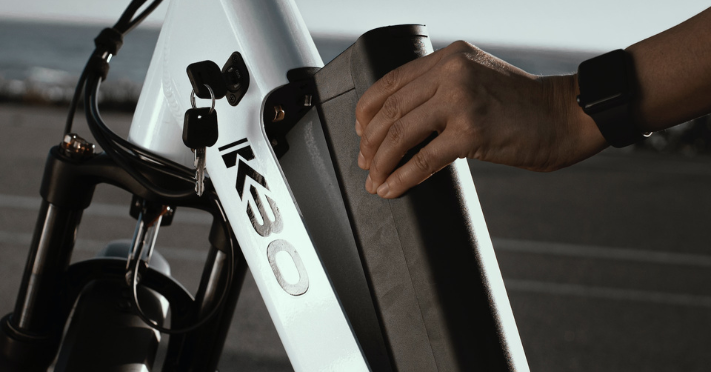The revolution in electric cars and consumer electronics has been powered thanks to lithium-ion (Li-ion) battery technology developments. The same batteries that power your smartphone and laptop also led to e-bikes becoming mainstream. Batteries were and remain the bottleneck in realizing fossil-fuel-free transportation, and the cost of Li-ion batteries is continually declining.
With companies like Uber, Ford, and GM getting into the business of pedal-assist bikes, 2018 marked a turning point in the e-bike industry. Companies like Bosch, Yamaha, and Shimano are leading the way by producing sophisticated drive systems. As more e-bikes get into the hands of consumers, it’s important to understand the best practices around caring for your bike’s battery.
A Short Step Back In Time
Just 15 years ago, most of us didn’t have phones with GPS, WiFi, 16MP cameras, and eight-core processors. Such power-hungry features need enormous power, and the crucial factor that enabled the electronic revolution was the Li-ion batteries. They pack a lot of energy in a small space, can last a couple of years with good care, and deliver reliable power in a lightweight package.
Most e-bike batteries are comprised of 18,650 cylindrical cells manufactured by companies like Panasonic, Samsung, and Sony. Just like any other battery, they have an anode, a cathode, and an electrolyte. The capacity of these anodes and cathodes to host the Li-ions and the engineering design account for the long lifecycle and high-energy density of modern-day batteries used in cars and phones.
Nissan Leaf uses a manganese oxide-based cathode, while Apple’s iPhone has a cobalt-based cathode. The energy densities differ based on what kind of chemistry you end up using. For example, you purchased a Trek e-bike with a Bosch PowerPack 500 battery. The battery consists of 10 cells in a series; four modules are connected in parallel. Each cell has a jelly roll of anodes and cathodes that produce the desired voltage and current required of the cell.
Many people wonder why their phone or laptop battery requires constant recharging and dies after one year, while some electric cars and hybrid car batteries seem to last 8–10 years. For context, a Prius battery lasts 250,000 miles or more, and the Tesla Model S has an eight-year, 100,000-mile battery warranty. However, taking proper care of your e-bike battery will last four to five years instead of one or two.
Maximizing Your E-Bike Battery
Most e-bikes run on either a 36-volt or 48-volt drive system. First, ensure you have the right charger which works effectively. If you purchase an e-bike online, you may want to be more cautious, as batteries can end up in shipping containers and warehouses for a long time and not receive proper care.
Plug your battery in and let it charge fully. Once fully charged, your charger should indicate this in some way (e.g., an LED will turn from red to green). Once fully charged, you may want to test ride and make sure there is no unexpected voltage sag.
E-Bike Battery Best Practices
The e-bike industry is rapidly evolving, and unfortunately, most manuals are outdated except for a few leading companies like Bosch or Yamaha. Your e-bike manual may tell you to turn the battery off after each ride, which simultaneously rings true and false. If you don’t care about the battery’s longevity, charge it after each ride, and the high-voltage cutoff (HVC) in the battery-management system (BMS) will shut it off when it reaches 100 percent.
This practice may provide roughly 400–500 cycles before there is a substantial degradation in the cell chemistry. However, if you do a few simple things, your battery may last longer than two years. This is also one of the reasons most e-bike manufacturers only provide a maximum two-year warranty.
A Tesla 80-kilowatt-hour battery pack costs approximately $40,000. That’s roughly $500 for each kilowatt-hour. Two 500-Wh (watt-hour) packs from Bosch (1 KWhr) may cost you almost $2,000. One may argue that Tesla has economies of scale and better thermal design, but price-per-pound e-bike batteries are much more expensive than car batteries. So it’s wise to understand how things work and how to enhance the battery’s life.
Avoid Temperature Tantrums
Do not expose your battery to very high temperatures (above 105 degrees Fahrenheit) for prolonged periods. High temperatures promote parasitic reactions within the battery and cause capacity loss. Leaving the battery in the trunk of your car on a hot summer day is one such example. If you do it occasionally, it’s okay, but repeated usage can lead to premature aging of the battery.
Do not charge your battery when it’s really cold. Let’s say you left your battery in an unheated garage in the dead of winter; you may want to bring the battery inside and wait for it to reach room temperature before charging. In cold conditions, the electrolytes become very dense, and the Li-ions have to push through a thick cloud of electrolytes. It’s like driving your car in a sea of thick honey. It slows the ions down and leads to the breakdown of the electrolyte component.
Charge your battery when it’s not too cold or too hot. Let’s say you just returned from a 50-mile ride, and the battery is pretty warm. Leave it for 30 minutes, so it’s back to room temperature. Ideally, charge your battery so it doesn’t sit fully charged for hours. So if your morning commute starts at 7:30 a.m., either charge your battery to 80% the night before or early that morning. Leaving the battery at 100% quickly degrades the chemistry.
Keep Timing In Mind
If you intend to use your bike soon after charging the battery, it’s fine to charge to 100%. If you cannot use it right after your charge, charging to approximately 80-90% can be beneficial. You can stop charging when the battery reaches the last stage (constant voltage mode if your battery has five LED bars to indicate the charge state) and then stop charging when it reaches the fifth bar, but it doesn’t need to be exact.
You can double the lifecycle of your battery by only charging it to 80%, so try to keep the state of charge between 20-80% where possible. A simple rule of thumb is that if you can drain the battery within an hour, it’s time to take a step back and consider whether you’re causing aggressive battery wear and tear. If your commute or riding pattern takes two to three hours before you can drain the battery to 10%, you’re fine. There are other cheaper options out there that do a similar job.
Important Battery Life Parameters
If you are interested in maximizing battery life, be mindful of these two parameters:
High temperature = BAD for Li-ion cells. Anything above 40 degrees Celsius or 105 degrees Fahrenheit should be considered high temperature – think the trunk of a car on a hot summer day or exposing the battery to direct sunlight in a place like Arizona.
Time (days or weeks) spent at high voltage = BAD for Li-ion cells. You charged the battery to 100% and went away for a long weekend. This may not be a good idea. Doing this occasionally is fine but repeated full charges can accelerate battery wear.
Store Your Battery Safely
It’s advisable to store your battery at room temperature (cool, less humid conditions) and 50% charge. If that’s not possible, just avoid storing at 100%. Every battery degrades over time due to repeated charge and discharge cycles, but degradation is minimal in the 30-70% zone. Also, store your battery away from hazardous materials like acids, corrosive industrial solvents, and any oxidizing agents.
Winter Battery Care
Electric cars can lose up to 30% range in cold climates. This is because of the increased resistance in the cell electrolytes, but the range is regained come spring. For this exact reason, cars like Tesla have an advanced battery cooling/heating system that always keeps their pack at approximately 70% temperature.
To retain warmth in very cold conditions, it is advised to use neoprene sleeves for your battery. This keeps the battery from dirt, mud, water, and salt and provides a temperature cocoon.
Battery Care Can Boost Your E-Bike Experience
Taking good care of your battery ensures it lasts longer, saving you money in the long term and maximizing your enjoyment of your e-bike. Getting the largest possible battery will deliver the greatest range, but avoid exposing batteries to high temperatures, charge them in a safe environment, and remember not to overcharge them. With these guidelines in mind, all batteries degrade over time, so get out there and get the most out of your e-bike and its battery.
Keen on more knowledge about how to perfect your e-bike experience? Discover how to choose the perfect electric bike and how to maximize your e-bike’s range.



